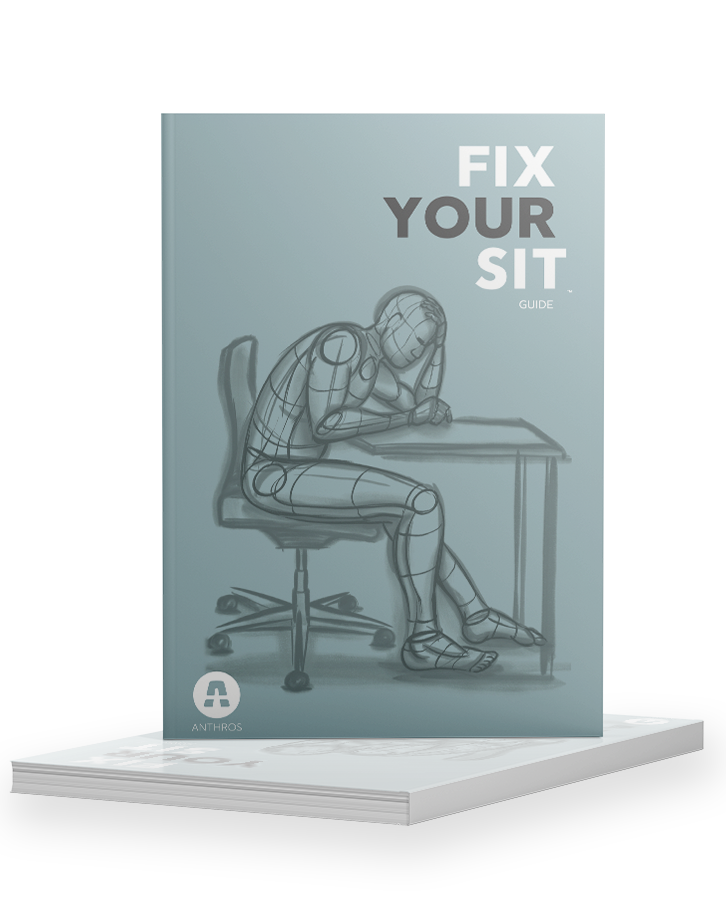SITTING IS VIRTUALLY UNAVOIDABLE
CAN WE FIND A WAY TO SIT WITHOUT COMPROMISING OUR POSTURE, HEALTH, AND PERFORMANCE?
Yes!This guide will shed light on the TRUTH about sitting and will offer solutions for sitting well.
Unwanted symptoms of prolonged sitting
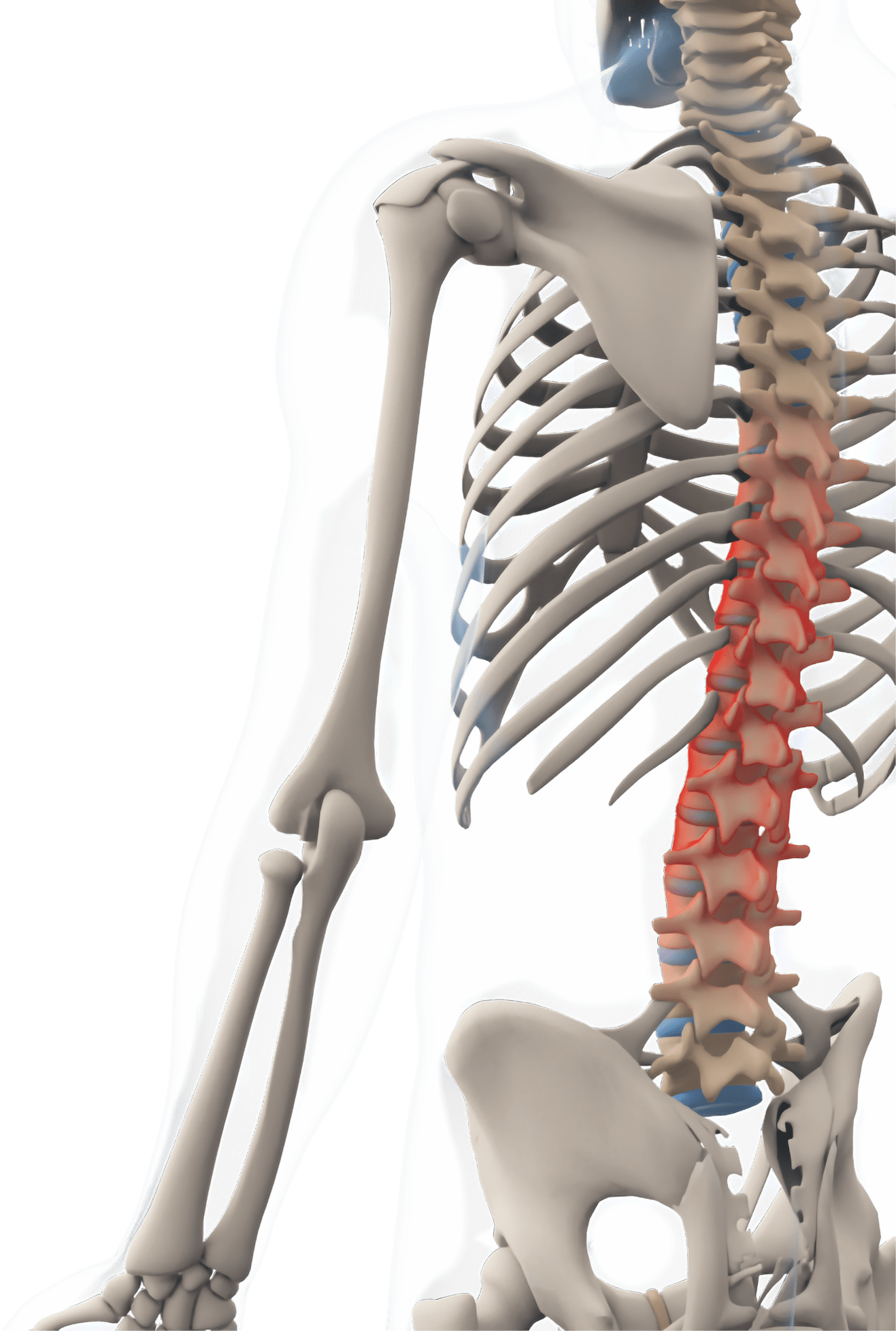
Back pain
in numbers
80%
80% of the general population will suffer from a severe episode of lower back pain at least once in their lifetime
31%
31% million Americans suffer from back pain at a given time.
25%
25% of American adults suffer from “chronic” back pain.
54%
54% of workers suffering with back pain spend most of their workday sitting down.
40%
As the leading contributor to sick days, back pain accounts for 40% of all missed work days and costs businesses in both worker loss and productivity loss.
$$$
Back disorders cost employers $1,685 per employee every year in productivity, a loss of $225.8 billion nationally
$$$
The average claim against an employer for back pain will pay between $40K and $80K. Those claims are not limited to jobs with a demanding physical workload.
A LOOK AT
SITTING POSTURE
WHAT IS “GOOD” POSTURE?
Optimal posture
To understand good posture, we need a refresher on simple anatomy.
At the base of the spine is the pelvis. The pelvis is connected to the spine with multiple ligaments, so when the pelvis moves, the spine moves with it.
WHY IS THIS AN OPTIMAL POSTURE?
While in a neutral position, the spine has four natural curves with intervertebral discs in between.
When properly supported at the pelvis, a neutral, strong, and healthy spinal posture should look like an “S”.
This posture creates increased disc space, allowing the muscles to relax in this stable position. However, in a slouched posture, the discs compress, resulting in pain over time.
This posture:
Improves circulation
+ digestion
Optimizes lung
capacity
Increases disc space, which decreases the risk of back pain
WHY IS GOOD POSTURE DIFFICULT TO MAINTAIN?
HINT:IT’S NOT YOUR FAULT!
Maintaining posture
Discomfort or pain is recognized by tiny pain sensors, called nociceptors located in the skin, joints, and muscles. These nociceptors send signals to the brain, and the body responds by changing positions.
triggering the nociceptors, and making it difficult to sit upright for long periods of time.
WHAT HAPPENS TO THE BODY DURING SITTING?
- 1When sitting without support, the pelvis rolls backward to seek comfort and stability. This motion flattens out the lumbar and lower spine.
- 2As the spine flattens in the lower region, the upper and thoracic spine falls forward.
- 3The neck and head then move forward to the body’s center, over its mass.
- 4This “C” posture has been linked to compressed intervertebral discs, muscular tension, and increased pressure and discomfort in the neck, back, and hip areas.
- 5As the upper spine falls forward, the shoulders rotate inward, increasing the risk for shoulder injuries.
- 6Coupled with increase hip flexion, this slumped posture results in weak glutes, shortened hamstrings, and tight hip flexor muscles.

THE AVERAGE PERSON WILL SPEND ROUGHLY 23 YEARS OF THEIR LIFE SITTING DOWN.
Difrancisco-Donoghue J et al. Managing the health of the eSport athlete: an integrated health management model. BMJ Open Sport and Exercise Medicine 2019.WHAT ARE THE RESULTS OF POOR SITTING POSTURE?
Sitting in poor posture affects the upper and lower body muscles
Over time, the “C” posture leads to some muscles becoming weaker and some becoming stronger, resulting in muscle imbalance.
Muscles, tendons, and ligaments adapt to positions over time. When the body is in the same position day after day, muscles and joints may become contracted and tight or stretched and weak, leading to restrictions of joint motion.
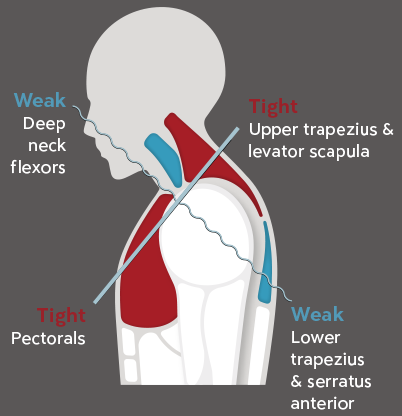
Upper body muscle imbalance
Sitting in a slouched posture lengthens and weakens opposing muscles.
Symptoms of this muscle imbalance may include:
- Neck pain
- Shoulder pain
- Decreased range of motion of the shoulders, mid-back, and neck
- Feeling of tightness or discomfort with shoulder or neck movements
Upper body muscle imbalance
Sitting in a slouched posture lengthens and weakens opposing muscles.
Symptoms of this muscle imbalance may include:
- Neck pain
- Shoulder pain
- Decreased range of motion of the shoulders, mid-back, and neck
- Feeling of tightness or discomfort with shoulder or neck movements
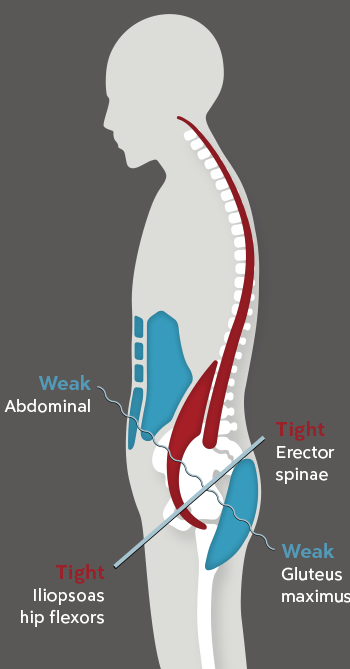
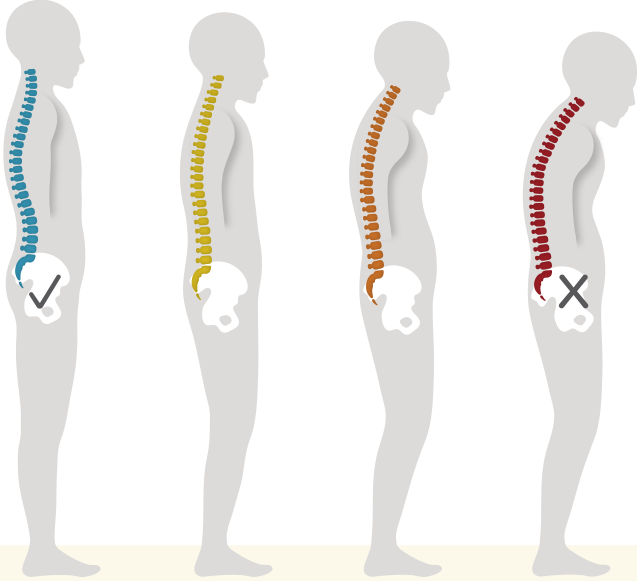
CAN SITTING POSTURE AFFECT STANDING POSTURE?
Yes!
Prolonged sitting leads to lower body muscle imbalance – namely, weakened glutes and abdominals and tight hip flexors and erector spinae – all factors leading to poor standing posture.
ARE STANDING DESKS THE BEST ALTERNATIVE TO SITTING?
Standing desks can be effective to offer short sitting breaks; however, using a standing desk can result in poor posture and muscle imbalances since it can’t offer the body postural support.
Studies have shown that prolonged standing can result in:
- low back pain
- physical fatigue
- muscle pain
- leg swelling
- tiredness
- body part discomfort
When comparing sitting to standing for multiple hours, those standing had the highest reports of discomfort, the most overall motion, and the highest spinal loads.
Accept a little short-term discomfort as the body adapts to the postural changes. Think of it like getting braces: short-term discomfort leads to a beautiful result!
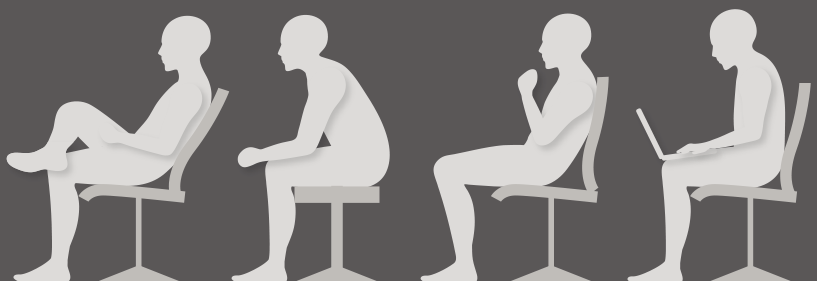

IS SITTING ALWAYS BAD?
No!
Sitting doesn’t have to be bad; unfortunately, most people are seated in chairs that don’t support the body in the right places.
Good news!It is possible to sit well, minimizing harmful muscle imbalances. Supporting the right parts of the body leads to an upright, elongated spine and better sitting and standing posture.
By sitting well in a good posture all day, every day, the body can be trained to an upright posture.
WHAT DOES IT TAKE TO UNDO THE EFFECTS OF BAD POSTURE?
Fixing poor sitting posture
Undoing the effects of bad posture can take time. Just like it took time for your body to change to a poor posture, it takes time for the body to adapt to a good posture!
It is a PROCESS. It’s important to:
- Develop new sitting habits - sit in a chair that supports the body in the right places and ease into your best posture.
- Remember, a chair can’t change your posture overnight - your body won’t be used to good posture so pushing too hard, or too fast to correct it can also result in discomfort.
- Work to stretch and strengthen - undo muscle imbalances by stretching and strengthening the right muscles (see exercises in Appendix B of the guidebook).
With intention and consistency in following this process, it can take anywhere from 1-6 months to see your best results!
THE SOLUTION TO GOOD
SITTING: ANTHROS
Designed by medical seating professionals with combined 70yrs+ experience in the wheelchair seating industry
Anthros has designed a revolutionary chair that supports the body in all the RIGHT places to keep you in good posture comfortably all day. When supported in the right places, you can experience:
- increased comfort
- decreased back, neck, shoulder, or buttocks pain
- decreased fidgeting and repositioning, increasing focus and performance
THE INGREDIENTS OF
GOOD SITTING
Based on research and sitting expertise, there are four key components to sitting well:
- 1Support the pelvis, not the lumbar
- 2Elongation of the spine
- 3Protection for the sit bones against high pressure
- 4Maintenance of good posture in resting position

1SUPPORT THE PELVIS, NOT THE LUMBAR
To support the pelvis in a neutral position, the office chair support must be at the top of the pelvis, NOT at the lumbar spine.
Stabilizing the pelvis, not the lumbar, as the base of support positions everything above in a neutral position and is the key to healthy sitting.

Think of the spine as a high-rise building: the concrete base, or the pelvis, is the foundation. The spinal column represents the multiple floors of the high rise. Traditional office chairs offer lumbar support that supports "the building" on the 5th floor rather than at the foundation.
Providing traditional lumbar support may cause strain to the structures above and below and ultimately result in a collapsed posture.
To promote healthy spinal curves, the support must be at the foundation, namely the pelvis. This results in a stable, upright, and pain-reducing posture.
Anthros has designed an adjustable low-back pelvis support that can accommodate individual shapes and sizes. It can be adjusted to meet the pelvis and hold it in a neutral posture, which is the foundation for upright sitting.
Could a lumbar support cause pain?
Yes!Traditional office chairs incorporate lumbar support in the backrest. A “one-size-fits-all” approach doesn’t work for most people.
As a result, the body shifts into a posture to avoid the aggressive lumbar support. Sitting incorrectly in the chair only exacerbates the feeling of discomfort, continuing the cycle.

A lumbar support that lacks proper pelvis support allows the hips and pelvis to slide forward on the seat, ultimately creating a pelvic tuck that leads to a slouched position.
When this happens, the lumbar support makes very aggressive contact above the lumbar region, which often leads to additional discomfort or pain.
THE SHAPE OF THE LUMBAR SPINE WHEN SITTING DEPENDS ON THE POSITION OF THE SACRUM CONNECTED TO THE PELVIS. THE SUPPORT SHOULD BE GIVEN TO THE PELVIS, NOT THE LUMBAR SPINE
2ELONGATION OF THE SPINE
Is a chair with a high back the best option?
No!
The common high-and-wide-back office chair is a contributor to bad posture. These chair backs are often contoured, and the contours don’t match the shape of the average person. The wide surface causes the shoulders to round forward, resulting in a slumped posture with a forward head.
Anthros has designed an adjustable tapered upper back support that acts as a “posture motivator”. It promotes the elongation of the spine, elevation of the rib cage, and lengthening of the abdominal muscles, resulting in a good, upright posture.
The taper allows the shoulders to be pulled back, bringing the elbows in line with the shoulder.
Will a tapered upper back support me? It looks too small!
When it comes to providing the best back support, it’s not the size that matters. Rather, it’s all about placement.
Even though the tapered upper back looks small compared to the traditional high and wide backs, it provides support only where needed. This allows movement where it’s wanted, namely for the shoulders.

3PROTECTION FOR THE SIT BONES AGAINST HIGH PRESSURE
When sitting for long periods of time on a mesh seat or a hard surface, the sit bones cause high-pressure areas that result in discomfort.
Most of us tuck the pelvis to relieve pressure from the sit bones.
Not only is posture compromised but comfort is also affected in this inefficient posture, which may also result in increased pain.
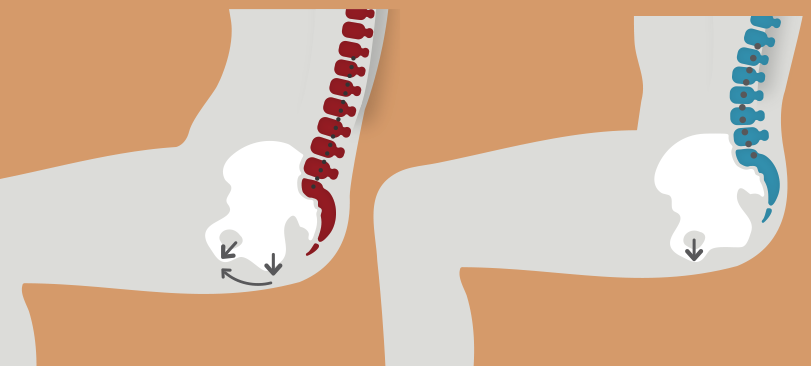
Mesh is not the best option!
A chair cushion with an adequate amount of contoured foam – not mesh – will increase sitting comfort by:
- reducing pressure on the sit bones
- aligning the legs in a neutral position
- decreasing the risk of sciatica
- supporting the pelvis in neutral to maintain an upright posture

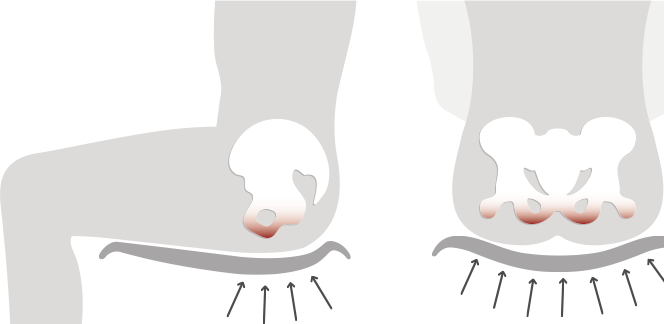

Contoured foam is the best option!
Based on the results of 3D human modeling, Anthros has added patented pressure-relieving cutouts under the sit bones, decreasing high peak pressures and increasing comfort.

SYSTEMS IN THE HUMAN BODY, INCLUDING THE NOCICEPTORS IN THE SKIN, RECORD THE CHANGES IN THE STRESSED SURFACE UNDER THE SIT BONES AND SEND THE INFORMATION TO THE BRAIN INFLUENCING INTERPRETATION AND EVALUATION OF SEAT COMFORT.
4MAINTENANCE OF GOOD POSTURE IN RESTING POSITION
A resting posture is important in an office chair, especially when taking a phone call or relaxing during the workday.

Recline
Opening the back angle causes the pelvis to tuck and slide forward in the seat. This results in a slumped “C” curve and forward head.
Tilt
The seat and back tilt rearward together, maintaining posture and alignment. This prevents sliding forward on the seat surface and avoids the unwanted effects of reclining.
TILT REORIENTS THE BODY IN SPACE TO REDUCE THE EFFECTS OF GRAVITY AND PROMOTE NEUTRAL POSTURE
CONCLUSION: ONLY ANTHROS IS DESIGNED WITH THE COMPONENTS OF GOOD SITTING
Most high-end “ergonomic” chairs lack one or more of the four
| ANTHROS | TRADITIONAL OFFICE CHAIRS | |
|---|---|---|
| Adjustable low back | ||
| Adjustable upper | ||
| Pressure-relieving cushion | ||
| Posture-saving gravity-assisted |

Info
Join our email list
Sign up to get special offers, the latest videos, news, + more.





